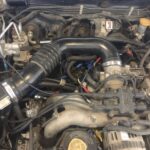Looking for a clear and concise OBD2 tutorial? This guide provides a comprehensive introduction to On-Board Diagnostics, covering everything from its history and benefits to practical tips on logging and decoding OBD2 data. Learn how to use OBD2 to diagnose car problems, improve performance, and gain valuable insights into your vehicle’s health.
What is OBD2?
OBD2 (On-Board Diagnostics II) is a standardized system that allows external devices to access diagnostic information from a vehicle’s computer. It’s essentially a computer interface built into your car, enabling you to monitor various parameters and identify potential issues. Think of it as your car’s built-in translator, converting complex data into actionable insights.
History of OBD2
Initially driven by emissions regulations, OBD2 evolved to become a comprehensive diagnostic tool. Early OBD systems were manufacturer-specific, making diagnostics complex and requiring specialized equipment. The standardization of OBD2 in the mid-1990s revolutionized vehicle diagnostics, providing a universal language for accessing vehicle data.
Benefits of OBD2
OBD2 offers numerous advantages, including:
- Simplified Diagnostics: A single OBD2 port provides access to all diagnostic data, eliminating the need for multiple connectors and specialized tools.
- Early Problem Detection: OBD2 can detect issues before they become major problems, saving you time and money on repairs.
- Improved Performance: By monitoring engine parameters, you can identify areas for optimization and improve fuel efficiency.
- Emissions Monitoring: OBD2 plays a crucial role in ensuring vehicles meet emissions standards, contributing to a cleaner environment.
OBD2 and the CAN Bus
OBD2 relies on the CAN (Controller Area Network) bus, a communication system that allows various electronic control units (ECUs) within a vehicle to communicate with each other. The CAN bus acts as a central nervous system, enabling seamless data exchange between different parts of the car.
OBD2 utilizes specific CAN messages, known as PIDs (Parameter IDs), to request information from the vehicle’s ECUs. Each PID corresponds to a specific parameter, such as engine speed, coolant temperature, or fuel pressure.
Logging and Decoding OBD2 Data: A Tuto OBD2 in Action
This Tuto Obd2 section will guide you through the process of logging and decoding OBD2 data.
1. Hardware Selection
You’ll need an OBD2 scanner or data logger to access the data. Options range from basic code readers to advanced devices capable of logging data over time.
2. Connecting to the OBD2 Port
Locate the OBD2 port, typically found under the dashboard on the driver’s side. Connect your chosen hardware to the port.
3. Data Logging
Use your device to log the desired OBD2 PIDs. The logged data will typically be in a raw format, requiring decoding for interpretation.
4. Data Decoding
To decode the raw data, you’ll need information on how the data is encoded within each PID. This information is often found in vehicle-specific documentation or online resources. Software tools can automate this process.
Conclusion: Mastering the Tuto OBD2
This tuto obd2 provided a foundational understanding of On-Board Diagnostics. By learning how to leverage OBD2 data, you can unlock valuable insights into your vehicle’s performance, diagnose problems effectively, and potentially save on repair costs. As vehicles become increasingly complex, understanding OBD2 will become even more critical for both professionals and car enthusiasts.


